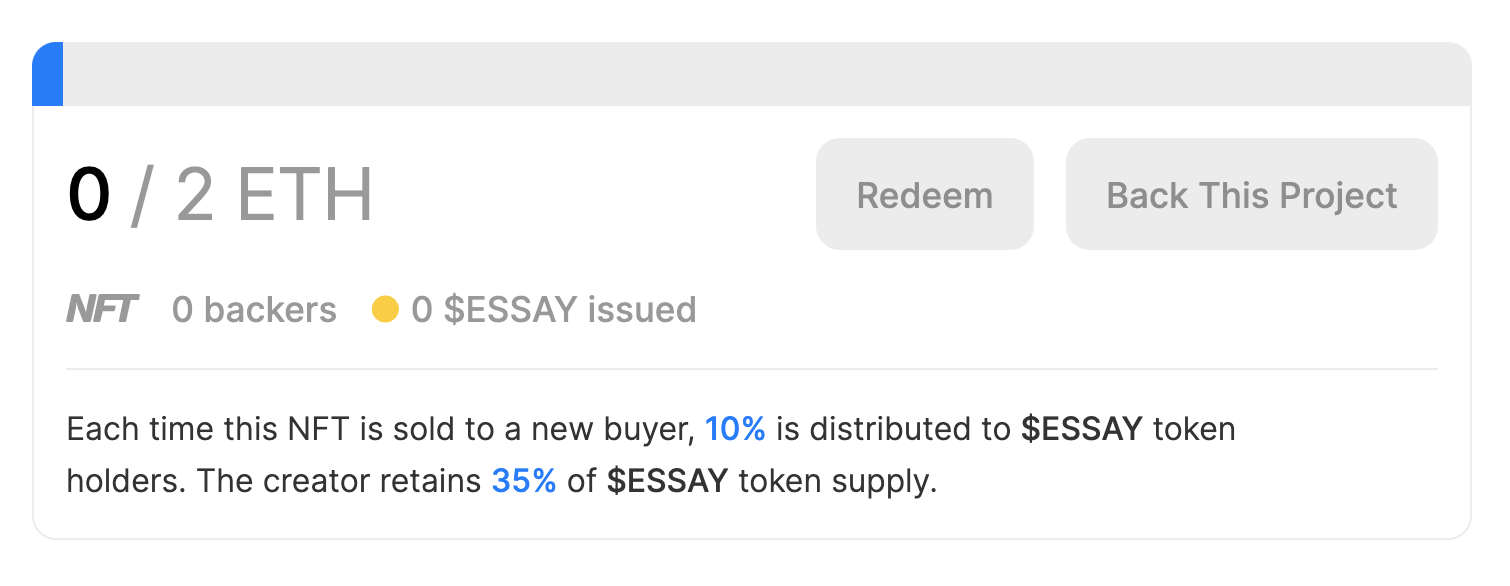The Coming Era of Tokenized Essays
Narrative economics and crypto-models for blogging
Money is having a bit of a moment right now.
Against the backdrop of Gamestop share trading via /r/wallstreetbets, and people buying tweets as NFTs, sometimes for ~$2k we’ve never seen more experimentation of media, markets and narratives.
In the middle of this - there’s a little experiment, that might turn out to be a big idea. John Palmer is launching his next essay as an NFT crypto-asset, with a pre-sale for the essay token:
I'm really excited to be trying something new this week: using crypto to crowdfund the next essay I'm writing, titled 'Scissor Labels.'
Instead of publishing my work for free, or putting it behind a paywall, I'm doing something in between: raising funds to produce a new essay in exchange for ownership of the work. This will allow me to devote my full time to writing the piece, while allowing it to exist as a public good for anyone to read.
Below is Mirror's new Crowdfunding Block, which contains everything you need to know about backing this project. The crowdfund will go live on Thursday, January 28th at 12pm PT.

Paid Subscribers vs Tokenized Essays
The existing Substack model is also having a moment. We’re living through a cambrian explosion of creators going straight to audience. The same week Slate Star Codex re-launches on Substack, Twitter acquires paid newsletter platform Revue and the Everything bundle raises $600k and launches their own platform.
The Substack model has proven highly effective. But it’s not the only model. Let’s sketch out a potential end-goal for an alternative tokenized model.
Today, your paid substack looks like this:

A flat fee per month, with a mix of paid and free newsletters. The paid ones are what you pay for, the free ones build hype and build audience.
Under tokenized model you get something that looks like this:

Where every post is free to read but every essay is an NFT - tradeable and ownable. It’s the same kind of idea of hype vs value - but skewed in some interesting ways.
But where this gets really interesting is when you add the pre-sale component that John is pioneering. Then you get something like this:

Here - every essay is a tradeable ownable NFT asset but upcoming essays go on sale via pre-sale of the tokens. This model allows all essays to be free to read but with significant hype and buzz-building potential of the pre-sale model.
Over time it’s not hard to imagine this model providing significant returns. How much do you think seminal blog posts like status as a service or the gervais principle might fetch as ownable NFTs?
Crypto Models Without Crypto Gatekeepers
What’s most interesting about this model is that the crypto-economics are all sub-surface. The essays are free to read so the majority of your audience is free to ignore the NFTs and simply enjoy the content. It’s a crypto implementation that doesn’t require large technical hurdles for the majority of your audience.
A New Kind of Bundling
Ok, but what if we keep extending this idea? Bundling is one of the next big ideas for platforms like Substack and bundles can make very obvious economic sense. But today - they typically require you to bundle platform and payment. This crytpo-economic model of tokenized essays however allows for a radical new way of bundling. Creators can bundle not at the platform layer (i.e. publishing at the same place) but at the protocol layer (i.e. by selling their works on the same token).
Through collaborating on a single token it’s possible to create an economic bundle distinct from the platform bundle - allowing all sorts of new ideas - and ownership models.
Honestly, I’m no expert in NFTs or crypto but I’m excited for the coming wave that might just usher in some exciting new models. And maybe we’ll bring back blogging in the process.
–
Update #1: One more observation. Just like the Friends with Benefits tokenized community you can automatically unlock other things (e.g. communities, assets, access) to anyone who currently owns one of your essays. This might be a nice elegant way to open up newsletter+community style models…..
Update #2: Perhaps this also unlocks even more radical forms of bundling - where there are ventures part employer owned, part individual owned. Or part community owned, exit to community style.
Update #3: John’s crowd-funding was successful:
Writers. @john_c_palmer just raised more than $13,000 to write an essay.
— Trev🙃r ~ skeet.eth (@whatdotcd) January 28, 2021
That is probably more than you'd get paid to write elsewhere.
Check out @viamirror - https://t.co/E92SDwNwA5
Working With Founders Who Have Conviction and Taste
April 16, 2024
March 20, 2024
This post was written by Tom Critchlow - blogger and independent consultant. Subscribe to join my occassional newsletter: